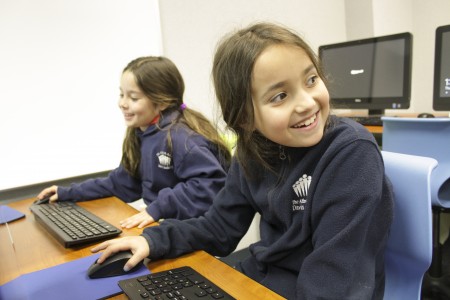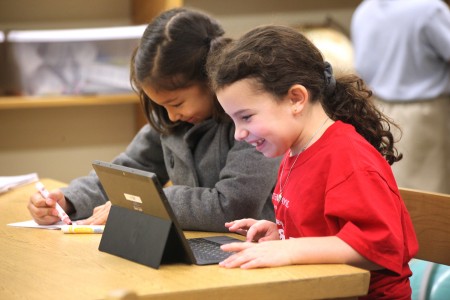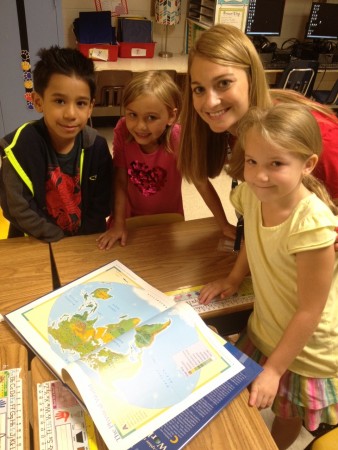
Editor’s note: This story is the first part of our Winter 2015 Education Guide. Stay tuned for more on the various language and cultural immersion programs taking place in and outside many classrooms, as well as news and tidbits from schools in our Reporter communities.
Gov. Nathan Deal wants Georgia graduates to get Georgia jobs. But right now, the workforce here can’t meet the demand for the manufacturing, technical and computer programming jobs that are available.
In response, many schools in Reporter Newspapers communities are implementing “career-readiness” programs and technical courses, including computer programming.
The recent Hour of Code, an international event intended to get students interested in writing computer programs, was embraced by many local schools, including Davis Academy.
Students were encouraged to participate in coding activities downloaded from the nonprofit’s website during the week of Dec. 8-12.
“They’re learning patience, creative thinking, critical skills, problem solving and resilience in trying to figure out how to work around a problem when getting stuck,” said Stacy Brown, 21st century learning coordinator at Davis. She was explaining that a roomful of second graders was learning how to create a video game.

“You have 60 seconds to create a monster — you have to do his mouth, his legs, his body,” second grader Ian Stukalsky said. “We’re learning how people make video games. It’s harder than I thought, because if you mess up, you will mess up the person that’s playing.”
Brown said that it’s widely thought that in 15 years students will have to be able to write computer code in order to be considered literate. “I believe it will be sooner,” she said, adding she wants to expose Davis students to the field because it can be very lucrative.
June Campbell, a business and computer science teacher at Riverwood International Charter School, said the high school participated in Hour of Code because it demonstrated that “anyone can learn it.” She said that next fall Riverwood will offer an AP computer science career pathway.
“Currently only a tiny fraction of students are learning computer science,” she said. “Careers in those fields are bursting at the seams with opportunities, but we don’t have the skill sets.”
Campbell said that it’s not just tech companies that need programmers. “Companies like Chase [Bank] have more programmers than Google,” she said.

The Hour of Code took off at North Springs Charter High School, as well. “I knew I wanted my students to participate and also any other interested students at North Springs,” said Sallie Holloway, a web and digital design teacher whose school scheduled an hour of coding as an after-school party so as not to get in the way of final exams.
“It was really successful,” she said. “Students and staff learned visual programming, HTML and Javascript during the hour. It was fun, they were really interested, and want to learn more.”
According to a press release from the school, students from the Future Business Leaders of America, the Architecture, Construction and Design Club, and the Computer Science Club helped mentor the students attending the Code party.
Campbell said activities like the Hour of Code and classes in computer programming better helps students see what’s out there.
“In Georgia we really want to meet the demand and not go outside the state for workers,” Campbell said. “We want our students to be prepared.”

It’s not just computer programmers that are needed. Last April, Deal signed a bill that gives full HOPE tuition to high-performing students in technical colleges, and he continues to push for training in film production and manufacturing – jobs that don’t necessarily require a four-year degree.
Brian Patterson, North Springs Charter High School’s work-based learning coordinator, says he thinks too much focus is placed on pushing students toward those four-year college degrees without exposing them to the real world.
“Great jobs are going unfilled, high-paying jobs that don’t require college degrees. Kids need to be exposed to that. There are welding jobs that only require two-year degrees,” he said.
Patterson said more students are getting involved in entrepreneurship, graphic arts and healthcare classes.
As the work-based learning coordinator, Patterson helps students find internships that align with their career aspirations so that they can get an idea whether that choice is right for them. In lieu of taking traditional classes, students in the program can leave school early to work at their jobs.
Patterson wants students in the field. “Hopefully they’ll figure out they love what they thought they loved, although sometimes that is not the case,” he said. “Either way, it’s a valuable learning experience.”

